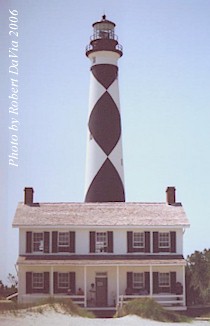
THE CAPE LOOKOUT LIGHTHOUSE

Graveyard of the Atlantic
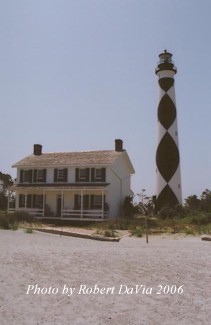
Inside the lantern, 13 oil lamps with parabolic reflectors produced a fixed white light that could be seen 16 to 18 miles out to sea. However, mariners found that the tower was too short and the beacon unreliable. Lieutenant H.J. Hartstene, United States Navy, commanding the United States mail steamer Illinois, stated in 1851 that “…the lights on Hatteras, Lookout and Cape Florida, if not improved had be better dispensed with as the navigator is apt to run ashore looking for them.”
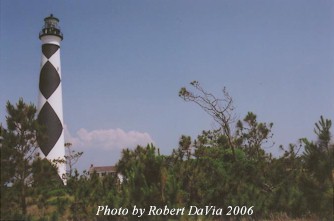
Construction on the second lighthouse tower began in 1857. It would become operational on November 1, 1859. This tower style was the first of its kind built on the Outer Banks.
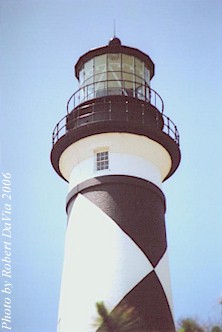
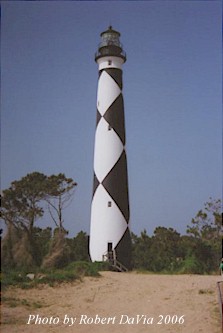
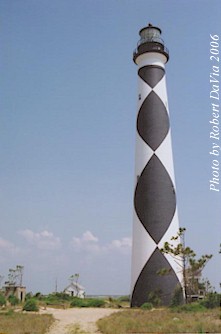
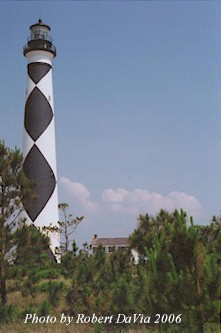
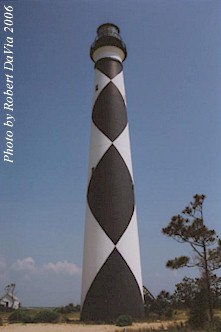
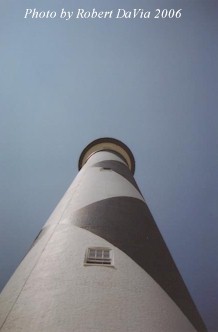
Lanterns, lenses and lamps
The old lighthouse had used a number of oil lamps to try and make its light brighter. For the new lighthouse, a more efficient lighting system was installed inside the lantern. Consisting of a single oil burning lamp inside a large, glass Fresnel (pronounced Frey-nel) lens, this system was a vast improvement.
The Fresnel Lens
A Fresnel lens has the appearance of a huge glass beehive. These lenses come in seven sizes or “orders.” A first order lens is the largest with a diameter of six feet. This size lens was used in coastal lighthouses such as Cape Lookout.
In 1979, this lens was replaced by two modern electric beacons. These beacons use 1000 watt electric light bulbs.
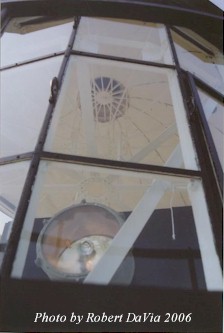 |
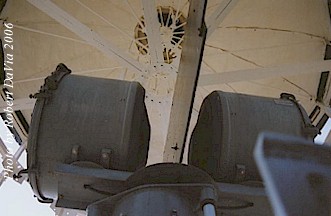 |
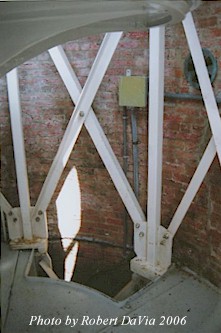
The hatch from the stairs into the watch room.
Notice the vent (behind the support) to keep air
flowing between the inner and outer walls of the tower.
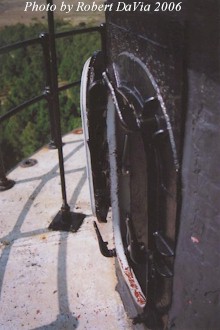
The hatch from the watch room to the gallery.
Fuel
Originally oil was used to fuel the lamps. Over the years the type of oil changed from whale oil to mineral oil (kerosene).
Eventually electricity became available for lighting. At first, gasoline powered generators were the only way to have electricity for the light. Today, an underwater cable running from Harkers Island supplies electricity to the lighthouse.
Light Characteristics
The heart of the lighthouse is the light that shines from the lantern at the top. This light can be either “fixed” (steady) or “flashing” (blinking). The color of the light can be white or red or green or a combination of these colors. These variations allow mariners to tell lighthouses apart at night.
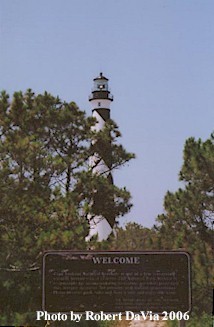
The light at Cape Lookout was a “fixed white” from 1812 until 1914. At that time, a clockwork device was added to the Fresnel lens to make the light appear to “flash”. Since that time the light has had various “flash” patterns. Currently the pattern is one “flash” every 15 seconds.
DAYMARKS
The painted pattern on a lighthouse is known as a “daymark..” From the deck of a ship at sea, it can be very difficult to tell one lighthouse from another. Daymarks help to distinguish one lighthouse from another during daylight hours.
Originally, the new Cape Lookout tower was left a natural solid brick red. But by 1872, new light towers at Cape Hatteras and Bodie Island were built. Since these two lighthouses looked the same as the Cape Lookout tower from a distance, it was decided to paint each one with a different daymark. Cape Lookout was painted in 1873.
The daymark chosen for Cape Lookout was officially called a “diagonal checker” pattern. It was painted on the tower in 1873. Today, most people refer to this pattern as “diamond” pattern.
This pattern has some unusual properties. The daymark is aligned with the black diamonds North/South and the white diamonds East/West. This makes the tower appear to change color when seen from different directions. Cape Lookout is the only lighthouse to change like this, all others remain the same regardless of viewing direction.
Located within the boundaries of Cape Lookout National Seashore the Cape Lookout lighthouse is still an important and active aid to navigation. Although the light is now automated, the United States Coast Guard – Group Fort Macon operates and maintains the lights. The lighthouse tower is closed for climbing.*
The nearby historic Assistant Keepers Quarters is open during the summer months as a visitor center. Displays, a bookstore and restrooms are available inside. During the summer, National Park Service rangers offer a variety of programs which begin at this location.
Through a special program, park volunteers staff the visitor center at the lighthouse and stay in the keeper’s quarters during the time that they volunteer.
Year Current Lighthouse completed
1859
Year painted with daymark pattern
1873
Year automated
1950
Height above sea level
169 ft.
Height above ground level
163 ft.
Focal plane of the lantern above mean high water
150 ft.
Wall thickness at base
9 ft.
Wall thickness at the top
1 ft. 7 in.
Base diameter
28 ft. 7 in.
Top diameter
13 ft. 3 in.
Number of steps in the staircase
201
Number of stair landings
7
Number of windows
10
Number of doors
2
A ship’s hatch provides access to the gallery around the top of the lighthouse.
Light produced by two rotating beacons.
Each 1000 watt bulb produces 800,000 candlepower
Light color
- white
Distance light seen out to sea 20
miles
Light pattern:
1 flash every 15 seconds
The above is from a handout
provided by the National Parks Service U.S. Department of the Interior Cape Lookout
National Seashore.
CLIMBING THE LIGHTHOUSE
Currently, the lighthouse is open for climbing four
times a year,
and is limited to approximately 240 people each day.
| MARCH | In honor of the establishment of Cape Lookout National Seashore on March 10, 1966 |
| JUNE | To commemorate the transfer of the Lighthouse from the US Coast Guard to the National Parks Service on June 14, 2003 |
| AUGUST | National Lighthouse Day: On August 7, 1789, by an Act of Congress, the Federal Government took responsibility for building and operating the nation’s lighthouses. |
| NOVEMBER | On November 1, 1859, Cape Lookout Lighthouse began operations. |
Dates for climbing are generally the Saturday closest to the above dates. Reservations must be made approximately three weeks in advance. Reservations may be made by calling: 252-728-5766 beginning at 9AM on the reservation day. For more information, see the web page at http://www.nps.gov/calo/
A VIEW FROM THE TOP
On Sunday, May 28, 2006, I was lucky to be in a group that was allowed to climb the Cape Lookout Lighthouse. Following are some pictures from the top of the tower.
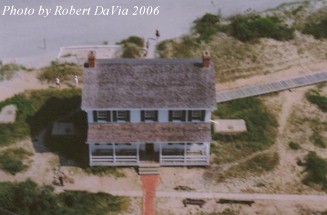
The Keeper's Quarters
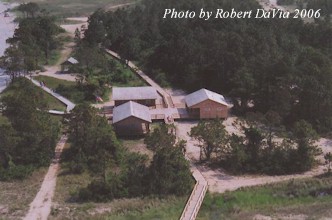
A view north, including the new additions
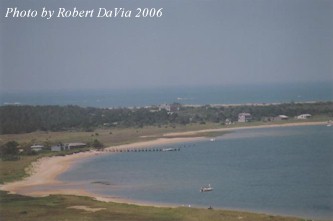
A view south - towards the old Coast Guard Station
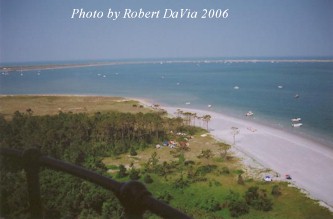
This view shows the recently completed beach renourishment.
Prior to this project, the water was nearly to the green ground cover.
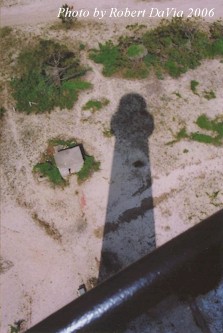
Looking down
MORE PICTURES
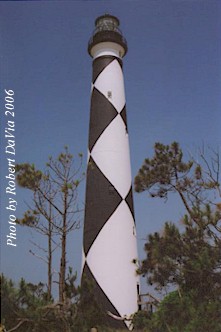
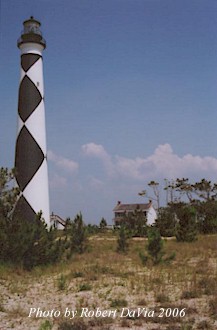
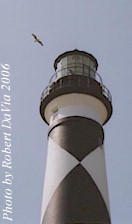
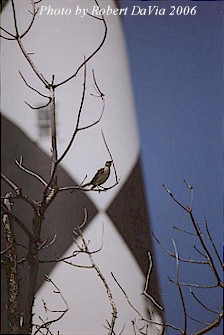
Return to the North Carolina State Page
Return to the: Alphabetical Listing or the Listing by States